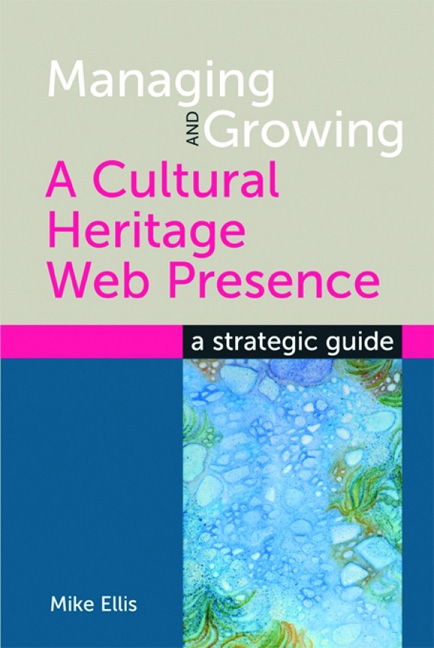Book contents
- Frontmatter
- Dedication
- Contents
- Acknowledgements
- Glossary
- Introduction
- 1 Evaluating what you have now
- 2 Building a strategic approach
- 3 Content
- 4 Marketing
- 5 Policies and guidelines
- 6 Traffic and metrics
- 7 The social web (Web 2.0)
- 8 The website project process
- 9 Away from the browser
- 10 Bringing it all together
- Bibliography
- Index
8 - The website project process
Published online by Cambridge University Press: 08 June 2018
- Frontmatter
- Dedication
- Contents
- Acknowledgements
- Glossary
- Introduction
- 1 Evaluating what you have now
- 2 Building a strategic approach
- 3 Content
- 4 Marketing
- 5 Policies and guidelines
- 6 Traffic and metrics
- 7 The social web (Web 2.0)
- 8 The website project process
- 9 Away from the browser
- 10 Bringing it all together
- Bibliography
- Index
Summary
Introduction
If you're part of a team helping to look after a cultural heritage web presence, you will probably at some stage have to go through some kind of development or redevelopment process. This might be small scale – for example, the build of some kind of microsite or subsection of your existing site – or it might be big – a complete reworking, redesign and relaunch of your entire website. For the purposes of this book, we'll think about a wholescale redevelopment of a website, including web design, technical build, new content writing and so on, but – obviously – adjust according to your particular needs. The process outlined here – analysis, specifying, building, testing – is similar no matter what sized project is being delivered.
Whichever kind of redevelopment you are considering undertaking, you should – of course – do it within the strategic framework we've been discussing throughout this book, making sure that you consider your users, your strategy and your existing approaches in a holistic way.
Given this, however, the process of working through a specific project, particularly a website redevelopment one, is fairly different from the daily approach you're already taking. You'll probably have a set timeline against which you need to deliver; you might also have a budget as well as external agencies involved. Once you're working with (and paying!) people outside of your organization, you will need a brief and possibly a specification, and in all likelihood some form of contract as well.
The specific approach you take to the project will depend very much on the scope, and also on how you work as an organization. Some institutions have very formal project management approaches, using methodologies such as Prince 2 – others use internal or external project managers and outsource all the work that is required to hold a project together from start to completion. Software development has its own complex set of approaches – again, the chosen one will be dependent on a number of factors: the agency that you choose, the size of the project, internal preferences and so on.
‘In a rapidly changing environment, creating excellent digital projects requires comprehensive planning, an understanding of the audiences, goals and content, a modicum of luck, and flexibility in implementation.'
Mia Ridge,
The Science Museum, UK- Type
- Chapter
- Information
- Managing and Growing a Cultural Heritage Web PresenceA strategic guide, pp. 149 - 178Publisher: FacetPrint publication year: 2011



